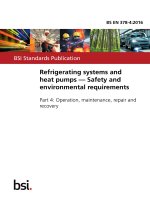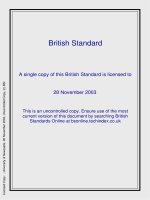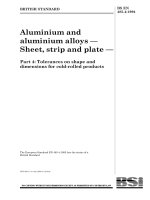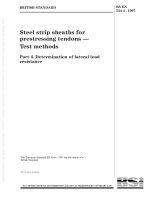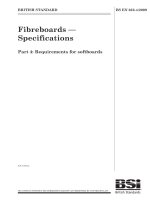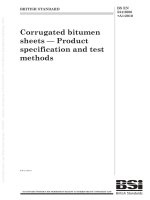Bsi bs en 61000 4 8 2010
Bạn đang xem bản rút gọn của tài liệu. Xem và tải ngay bản đầy đủ của tài liệu tại đây (1.1 MB, 38 trang )
BS EN 61000-4-8:2010
BSI Standards Publication
Electromagnetic compatibility
(EMC)
Part 4-8: Testing and measurement techniques —
Power frequency magnetic field immunity test
BRITISH STANDARD
BS EN 61000-4-8:2010
National foreword
This British Standard is the UK implementation of EN 61000-4-8:2010. It is
identical to IEC 61000-4-8:2009. It supersedes BS EN 61000-4-8:1994, which
will be withdrawn on 1 February 2013.
The UK participation in its preparation was entrusted by Technical Committee
GEL/210, EMC - Policy committee, to Subcommittee GEL/210/12, EMC basic,
generic and low frequency phenomena Standardization.
A list of organizations represented on this committee can be obtained on
request to its secretary.
This publication does not purport to include all the necessary provisions of a
contract. Users are responsible for its correct application.
© BSI 2010
ISBN 978 0 580 61441 5
ICS 33.100.20
Compliance with a British Standard cannot confer immunity from
legal obligations.
This British Standard was published under the authority of the Standards
Policy and Strategy Committee on 30 April 2010.
Amendments issued since publication
Amd. No.
Date
Text affected
BS EN 61000-4-8:2010
EN 61000-4-8
EUROPEAN STANDARD
NORME EUROPÉENNE
EUROPÄISCHE NORM
February 2010
ICS 33.100.20
Supersedes EN 61000-4-8:1993 + A1:2001
English version
Electromagnetic compatibility (EMC) Part 4-8: Testing and measurement techniques Power frequency magnetic field immunity test
(IEC 61000-4-8:2009)
Compatibilité électromagnétique (CEM) Partie 4-8: Techniques d'essai
et de mesure Essai d'immunité au champ magnétique
à la fréquence du réseau
(CEI 61000-4-8:2009)
Elektromagnetische Verträglichkeit (EMV) Teil 4-8: Prüf- und Mverfahren Prüfung der Stưrfestigkeit gegen
Magnetfelder mit energietechnischen
Frequenzen
(IEC 61000-4-8:2009)
This European Standard was approved by CENELEC on 2010-02-01. CENELEC members are bound to comply
with the CEN/CENELEC Internal Regulations which stipulate the conditions for giving this European Standard
the status of a national standard without any alteration.
Up-to-date lists and bibliographical references concerning such national standards may be obtained on
application to the Central Secretariat or to any CENELEC member.
This European Standard exists in three official versions (English, French, German). A version in any other
language made by translation under the responsibility of a CENELEC member into its own language and notified
to the Central Secretariat has the same status as the official versions.
CENELEC members are the national electrotechnical committees of Austria, Belgium, Bulgaria, Croatia, Cyprus,
the Czech Republic, Denmark, Estonia, Finland, France, Germany, Greece, Hungary, Iceland, Ireland, Italy,
Latvia, Lithuania, Luxembourg, Malta, the Netherlands, Norway, Poland, Portugal, Romania, Slovakia, Slovenia,
Spain, Sweden, Switzerland and the United Kingdom.
CENELEC
European Committee for Electrotechnical Standardization
Comité Européen de Normalisation Electrotechnique
Europäisches Komitee für Elektrotechnische Normung
Central Secretariat: Avenue Marnix 17, B - 1000 Brussels
© 2010 CENELEC -
All rights of exploitation in any form and by any means reserved worldwide for CENELEC members.
Ref. No. EN 61000-4-8:2010 E
BS EN 61000-4-8:2010
-2-
EN 61000-4-8:2010
Foreword
The text of document 77A/694/FDIS, future edition 2 of IEC 61000-4-8, prepared by SC 77A, Low
frequency phenomena, of IEC TC 77, Electromagnetic compatibility, was submitted to the IEC-CENELEC
parallel vote and was approved by CENELEC as EN 61000-4-8 on 2010-02-01.
This European Standard supersedes EN 61000-4-8:1993 + A1:2001.
EN 61000-4-8:2010 includes the following significant technical changes with respect to
EN 61000-4-8:1993: the scope is extended in order to cover 60 Hz. Characteristics, performance and
verification of the test generator and related inductive coils are revised. Modifications are also introduced
in the test set-up (GRP) and test procedure.
The following dates were fixed:
– latest date by which the EN has to be implemented
at national level by publication of an identical
national standard or by endorsement
(dop)
2010-11-01
– latest date by which the national standards conflicting
with the EN have to be withdrawn
(dow)
2013-02-01
Annex ZA has been added by CENELEC.
__________
Endorsement notice
The text of the International Standard IEC 61000-4-8:2009 was approved by CENELEC as a European
Standard without any modification.
In the official version, for Bibliography, the following notes have to be added for the standards indicated:
IEC 60068-1
NOTE Harmonized as EN 60068-1.
IEC 61000-2-4
NOTE Harmonized as EN 61000-2-4.
__________
BS EN 61000-4-8:2010
EN 61000-4-8:2010
-3-
Annex ZA
(normative)
Normative references to international publications
with their corresponding European publications
The following referenced documents are indispensable for the application of this document. For dated
references, only the edition cited applies. For undated references, the latest edition of the referenced
document (including any amendments) applies.
NOTE When an international publication has been modified by common modifications, indicated by (mod), the relevant EN/HD
applies.
Publication
Year
Title
EN/HD
Year
IEC 60050-161
-
International Electrotechnical Vocabulary
(IEV) Chapter 161: Electromagnetic compatibility
-
-
BS EN 61000-4-8:2010
–2–
61000-4-8 IEC:2009
CONTENTS
INTRODUCTION.....................................................................................................................6
1
Scope ...............................................................................................................................7
2
Normative references .......................................................................................................7
3
Terms and definitions .......................................................................................................7
4
General ............................................................................................................................8
5
Test levels ........................................................................................................................9
6
Test equipment............................................................................................................... 10
6.1
6.2
6.3
General ................................................................................................................. 10
Test generator ....................................................................................................... 10
6.2.1 Current source........................................................................................... 10
6.2.2 Characteristics and performances of the test generator for different
inductive coils............................................................................................ 10
6.2.3 Verification of the characteristics of the test generator .............................. 11
Inductive coil ......................................................................................................... 12
6.3.1 Field distribution ........................................................................................ 12
6.3.2
Characteristics of the inductive standard coils 1 m × 1 m and
1 m × 2,6 m ............................................................................................... 12
6.3.3
7
Characteristics of the inductive coils for table top and floor standing
equipment ................................................................................................. 12
6.3.4 Measurement of the inductive coil factor .................................................... 13
6.4 Test and auxiliary instrumentation ......................................................................... 13
6.4.1 Test instrumentation .................................................................................. 13
6.4.2 Auxiliary instrumentation ........................................................................... 14
Test set-up ..................................................................................................................... 14
8
7.1
7.2
7.3
7.4
7.5
Test
Test set-up components ........................................................................................ 14
Ground (reference) plane for floor standing equipment .......................................... 14
Equipment under test ............................................................................................ 14
Test generator ....................................................................................................... 15
Inductive coil ......................................................................................................... 15
procedure ............................................................................................................... 15
8.1
8.2
9
General ................................................................................................................. 15
Laboratory reference conditions ............................................................................ 15
8.2.1 General ..................................................................................................... 15
8.2.2 Climatic conditions .................................................................................... 15
8.2.3 Electromagnetic conditions ........................................................................ 16
8.3 Carrying out the test .............................................................................................. 16
Evaluation of the test results .......................................................................................... 17
10 Test report...................................................................................................................... 17
Annex A (normative) Inductive coil calibration method ......................................................... 22
Annex B (normative) Characteristics of the inductive coils ................................................... 23
Annex C (informative) Selection of the test levels ................................................................ 29
Annex D (informative) Information on power frequency magnetic field strength .................... 31
Bibliography.......................................................................................................................... 33
BS EN 61000-4-8:2010
61000-4-8 IEC:2009
–3–
Figure 1 – Example of application of the test field by the immersion method ........................ 18
Figure 2 – Example of schematic circuit of the test generator for power frequency
magnetic field ....................................................................................................................... 18
Figure 3 – Example of test set-up for table-top equipment .................................................... 19
Figure 4 – Calibration of the standard coils ........................................................................... 19
Figure 5 – Example of test set-up for floor-standing equipment ............................................. 20
Figure 6 – Example of investigation of susceptibility to magnetic field by the proximity
method with the 1 m × 1 m inductive coil ............................................................................... 20
Figure 7 – Illustration of Helmholtz coils ............................................................................... 21
Figure B.1 – Characteristics of the field generated by a square inductive coil (1 m
side) in its plane ................................................................................................................... 25
Figure B.2 – 3 dB area of the field generated by a square inductive coil (1 m side) in its
plane .................................................................................................................................... 25
Figure B.3 – 3 dB area of the field generated by a square inductive coil (1 m side) in
the mean orthogonal plane (component orthogonal to the plane of the coil) .......................... 26
Figure B.4 – 3 dB area of the field generated by two square inductive coils (1 m side)
0,6 m spaced, in the mean orthogonal plane (component orthogonal to the plane of
the coils) ............................................................................................................................... 26
Figure B.5 – 3 dB area of the field generated by two square inductive coils (1 m side)
0,8 m spaced, in the mean orthogonal plane (component orthogonal to the plane of
the coils) ............................................................................................................................... 27
Figure B.6 – 3 dB area of the field generated by a rectangular inductive coil (1 m × 2,6 m)
in its plane ............................................................................................................................ 27
Figure B.7 – 3 dB area of the field generated by a rectangular inductive coil (1 m × 2,6 m)
in its plane (ground plane as a side of the inductive coil) ...................................................... 28
Figure B.8 – 3 dB area of the field generated by a rectangular inductive coil (1 m × 2,6 m)
with ground plane, in the mean orthogonal plane (component orthogonal to the plane of
the coil) ................................................................................................................................ 28
Table 1 – Test levels for continuous field ................................................................................9
Table 2 – Test levels for short duration: 1 s to 3 s................................................................. 10
Table 3 – Specification of the generator for different inductive coils ...................................... 11
Table 4 – Verification parameter for the different inductive coils ........................................... 11
Table D.1 – Values of the maximum magnetic field produced by household appliances
(results of the measurements of 100 different devices of 25 basic types) .............................. 31
Table D.2 – Values of the magnetic field generated by a 400 kV line .................................... 31
Table D.3 – Values of the magnetic field in high voltage sub-station areas .......................... 32
Table D.4 – Values of the magnetic field in power plants ...................................................... 32
BS EN 61000-4-8:2010
–6–
61000-4-8 IEC:2009
INTRODUCTION
This standard is part of the IEC 61000 series of standards, according to the following
structure:
Part 1: General
General considerations (introduction, fundamental principles)
Definitions, terminology
Part 2: Environment
Description of the environment
Classification of the environment
Compatibility levels
Part 3: Limits
Emission limits
Immunity limits (in so far as they do not fall under the responsibility of the product
committees)
Part 4: Testing and measurement techniques
Measurement techniques
Testing techniques
Part 5: Installation and mitigation guidelines
Installation guidelines
Mitigation methods and devices
Part 9: Miscellaneous
Each part is further subdivided into several parts, published either as international standards,
as technical specifications or technical reports, some of which have already been published
as sections. Others will be published with the part number followed by a dash and a second
number identifying the subdivision (example: IEC 61000-6-1).
This part is an international standard which gives immunity requirements and test procedures
related to "power frequency magnetic field".
BS EN 61000-4-8:2010
61000-4-8 IEC:2009
–7–
ELECTROMAGNETIC COMPATIBILITY (EMC) –
Part 4-8: Testing and measurement techniques –
Power frequency magnetic field immunity test
1
Scope
This part of IEC 61000 relates to the immunity requirements of equipment, only under
operational conditions, to magnetic disturbances at power frequencies 50 Hz and 60 Hz
related to:
–
residential and commercial locations;
–
industrial installations and power plants;
–
medium voltage and high voltage sub-stations.
The applicability of this standard to equipment installed in different locations is determined by
the presence of the phenomenon, as specified in Clause 4. This standard does not consider
disturbances due to capacitive or inductive coupling in cables or other parts of the field
installation.
Other IEC standards dealing with conducted disturbances cover these aspects.
The object of this standard is to establish a common and reproducible basis for evaluating the
performance of electrical and electronic equipment for household, commercial and industrial
applications when subjected to magnetic fields at power frequency (continuous and short
duration field).
The standard defines:
–
recommended test levels;
–
test equipment;
–
test set-up;
–
test procedure.
2
Normative references
The following referenced documents are indispensable for the application of this document.
For dated references, only the edition cited applies. For undated references, the latest edition
of the referenced document (including any amendments) applies.
IEC 60050(161), International Electrotechnical Vocabulary (IEV) – Chapter 161: Electromagnetic compatibility
3
Terms and definitions
For the purposes of this document the following terms and definitions apply to the restricted
field of magnetic disturbances as well as the terms and definitions from IEC 60050(161) [IEV].
3.1
current distortion factor
ratio of the root-mean square value of the harmonics content of an alternating current to the
root-mean square value of the fundamental current
BS EN 61000-4-8:2010
–8–
61000-4-8 IEC:2009
3.2
EUT
equipment under test
3.3
inductive coil
conductor loop of defined shape and dimensions, in which flows a current, generating a
magnetic field of defined constancy in its plane and in the enclosed volume
3.4
inductive coil factor
ratio between the magnetic field strength generated by an inductive coil of given dimensions
and the corresponding current value; the field is that measured at the centre of the coil plane,
without the EUT
3.5
immersion method
method of application of the magnetic field to the EUT, which is placed in the centre of an
inductive coil (see Figure 1)
3.6
proximity method
method of application of the magnetic field to the EUT, where a small inductive coil is moved
along the side of the EUT in order to detect particularly sensitive areas
3.7
ground (reference) plane
GRP
flat conductive surface whose potential is used as a common reference for the magnetic field
generator and the auxiliary equipment (the ground plane can be used to close the loop of the
inductive coil, as in Figure 5)
[IEV 161-04-36, modified]
3.8
decoupling network, back filter
electrical circuit intended to avoid reciprocal influence with other equipment not submitted to
the magnetic field immunity test
4
General
The magnetic fields to which equipment is subjected may influence the reliable operation of
equipment and systems.
The following tests are intended to demonstrate the immunity of equipment when subjected to
power frequency magnetic fields related to the specific location and installation condition of
the equipment (e.g. proximity of equipment to the disturbance source).
The power frequency magnetic field is generated by power frequency current in conductors
or, more seldom, from other devices (e.g. Ieakage of transformers) in the proximity of
equipment.
As for the influence of nearby conductors, one should differentiate between:
–
the current under normal operating conditions, which produces a steady magnetic field,
with a comparatively small magnitude;
BS EN 61000-4-8:2010
61000-4-8 IEC:2009
–
–9–
the current under fault conditions which can produce comparatively high magnetic fields
but of short duration, until the protection devices operate (a few milliseconds with fuses, a
few seconds for protection relays).
The test with a steady magnetic field may apply to all types of equipment intended for public
or industrial low voltage distribution networks or for electrical plants.
The test with a short duration magnetic field related to fault conditions, requires test levels
that differ from those for steady-state conditions; the highest values apply mainly to
equipment to be installed in exposed places of electrical plants.
The test field waveform is that of power frequency.
In many cases (household areas, sub-stations and power plant under normal conditions), the
magnetic field produced by harmonics is negligible.
5
Test levels
The preferential range of test levels, respectively for continuous and short duration application
of the magnetic field, applicable to distribution networks at 50 Hz and 60 Hz, is given in Table 1
and Table 2.
The magnetic field strength is expressed in A/m; 1 A/m corresponds to a free space magnetic
flux density of 1,26 μT.
Table 1 – Test levels for continuous field
Level
Magnetic field strength
A/m
1
1
2
3
3
10
4
30
5
100
xa
special
a "x" can be any level, above, below or in-between
the other levels. This level can be given in the product
specification.
BS EN 61000-4-8:2010
– 10 –
61000-4-8 IEC:2009
Table 2 – Test levels for short duration: 1 s to 3 s
Level
Magnetic field strength
A/m
1
n.a. b
2
n.a. b
3
n.a. b
4
300
5
1 000
xa
special
a "x" can be any level, above, below or in-between
the other levels. This level, as well the duration of the
test, can be given in the product specification.
b
"n.a." = not applicable.
Information on the selection of the test levels is given in Annex C.
Information on actual levels is given in Annex D.
6
Test equipment
6.1
General
The test magnetic field is obtained by a current flowing in an inductive coil; the application of
the test field to the EUT is by the immersion method.
An example of application of the immersion method is given in Figure 1.
The test equipment includes the current source (test generator), the inductive coil and
auxiliary test instrumentation, that are also given in Figure 3.
6.2
6.2.1
Test generator
Current source
The current source typically consists of a voltage regulator (connected to the mains
distribution network, or other sources), a current transformer and a circuit for the control of
short duration application. The generator shall be able to operate in continuous mode or short
duration mode.
The connection between the current transformer and the inductive coil input should be as
short as possible to avoid that the currents which flow in the connection produce magnetic
fields that affect the magnetic field in the test volume. Preferably the cables should be twisted
together.
The characteristics and performances of the current source or test generator for the different
fields and for different inductive coils considered in this standard, are given in 6.2.2.
6.2.2
Characteristics and performances of the test generator for different inductive
coils
Table 3 specifies characteristics and performances of the test generator for different inductive
coils.
BS EN 61000-4-8:2010
61000-4-8 IEC:2009
– 11 –
Table 3 – Specification of the generator for different inductive coils
With standard square
coil
1 m × 1 m 1 turn
With standard
rectangular coil
1 m × 2,6 m 1 turn
With other inductive
coils
Output current range for
continuous operation
1 A up to 120 A
1 A up to 160 A
As necessary to
achieve required field
strength in Table 4
Output current range for short
duration
320 A up to 1 200 A
500 A up to 1 600 A
As necessary to
achieve required field
strength in Table 4
Current/Magnetic field
waveform
Sinusoidal
Sinusoidal
Sinusoidal
≤8 %
≤8 %
≤8 %
Continuous mode
Up to 8 h
Up to 8 h
Up to 8 h
Short time operation
1s up to 3 s
1s up to 3 s
1 s up to 3 s
Transformer output
Floating not connected to
PE
Floating not connected to
PE
Floating not connected
to PE
Current distortion factor
The schematic circuit of the generator is given in Figure 2.
6.2.3
Verification of the characteristics of the test generator
In order to compare the results for different test generators, the essential characteristics of
the current parameters in the standard inductive coils shall be verified.
The characteristics to be verified are:
–
current value in the standard inductive coils;
–
field strength in all other inductive coils;
–
total distortion factor in the inductive coils.
For standard inductive coils the verifications shall be carried out with a current probe and
measurement instrumentation having better than ±2 % accuracy. Figure 4 shows the
verification set-up.
For all other inductive coils the verification should be carried out with field strength meter,
having an <±1dB accuracy.
Table 4 – Verification parameter for the different inductive coils
Table 1
Level
Current values for the
1 m × 1 m standard coil
A
Current values for the
1 m × 2,6 m standard coil
A
Field strength in the centre for
all other inductive coils
A/m
1
1,15
1,51
1
2
3,45
4,54
3
3
11,5
15,15
10
4
34,48
45,45
30
5
114,95
151,5
100
BS EN 61000-4-8:2010
– 12 –
61000-4-8 IEC:2009
Inductive coil
6.3
6.3.1
Field distribution
For the two 1 turn standard coils 1 m × 1 m and 1 m × 2,6 m, the field distribution is known
and shown in Annex B. Therefore, no field verification or field calibration is necessary, the
current measurement as shown in Figure 4 is sufficient.
Other coils such as multi-turn coils may be used in order to have a lower testing current, or for
EUT not fitting into the two standard coils, inductive coils of different dimensions may be
used. For these cases, the field distribution (maximum variation of ±3 dB) shall be verified.
6.3.2
Characteristics of the inductive standard coils 1 m × 1 m and 1 m × 2,6 m
The inductance for the 1 turn standard 1 m × 1 m coil is approximately 2,5 μH, for the 1 m ×
2,6 m standard coil approximately 6 μH.
The inductive coil shall be made of copper, aluminium or any conductive non-magnetic
material, of such cross-section and mechanical arrangement as to facilitate its stable
positioning during the tests. For continuous tests up to 100 A/m the cross section of
aluminium should be 1,5 cm 2 and for short time test up to 1 000 A/m the cross section should
be 4 cm 2 .
The tolerance of the standard coils is ±1 cm, measured between the centre lines (centre of
the cross section). The characteristics of inductive coils with respect to the magnetic field
distribution are given in Annex B.
6.3.3
Characteristics of the inductive coils for table top and floor standing equipment
The list below gives the testing requirements for table top and floor standing equipment.
a) Inductive coil for table-top equipment
The inductive coil of standard dimensions for testing small equipment (e.g. computer
monitors, watt-hour meters, transmitters for process control, etc.) has a square form with
1 m side. The test volume of the standard square coil is 0,6 m × 0,6 m × 0,5 m (height).
Any other coils can be used to obtain a field homogeneity better than 3 dB.
For example, a double coil of standard size (Helmholtz coil) could be used in order to
obtain a field homogeneity better than 3 dB or for testing larger EUTs.
The double coil (Helmholtz coil) shall be comprised of two or more series of turns, properly
spaced (see Figure 7, Figure B.4, Figure B.5).
The test volume of a double standard size coil, 0,8 m spaced, for a 3 dB homogeneity is
0,6 m × 0,6 m × 1 m (height).
For example, the Helmholtz coils, for a 0,2 dB inhomogeneity, have dimensions and
separation distances as given in Figure 7.
No GRP is permitted as part of the coil nor on the insulating table below the EUT (see
Figure 3).
b) Inductive coil for floor-standing equipment
The inductive coil of standard dimensions for testing floor standing equipment (e.g. racks,
etc.) has a square form with 1 m side and 2,6 m height.
The test volume of the standard square coil is 0,6 m × 2 m (height) × 0,6 m.
When an EUT does not fit into the standard inductive coil 1 m × 2,6 m, the product
committee should select the test method: either the proximity method with the standard
1 m × 1 m 1 turn inductive coil (Figure 6 is an example) or inductive coils shall be made
BS EN 61000-4-8:2010
61000-4-8 IEC:2009
– 13 –
according to the dimensions of the EUT and the different field orientation of the magnetic
field.
Note that larger inductive coils give comparable results, but it may be not practicable to
construct very large coils. In this case the proximity method may give useful but not
necessarily reproducible results.
A GRP shall be present as in Figure 5.
NOTE Due to the possible large dimensions of EUTs, the coils may be made of "C" or "T" sections in order to
have sufficient mechanical rigidity.
6.3.4
Measurement of the inductive coil factor
In order to make it possible to compare the test results from different test equipment, the
inductive coil factor shall be measured without the EUT, in free space condition.
For the two 1 turn standard coils 1 m × 1 m and 1 m × 2,6 m, the field distribution is known
and shown in Annex B. Therefore, neither field verification nor field calibration is necessary,
the current measurement, as shown in Figure 4, is sufficient.
For all other inductive coils the following procedure shall be carried out. An inductive coil of
the correct dimensions for the EUT dimensions, shall be positioned at 1 m minimum distance
from the wall of the laboratory and any magnetic material, by using insulating supports, and
the inductive coil shall be connected to the test generator as prescribed in 6.2.
An appropriate magnetic field sensor shall be used to verify the magnetic field strength
generated by the inductive coil.
The field sensor shall be positioned at the centre of the inductive coil (without the EUT) and
with suitable orientation to detect the maximum value of the field.
The current in the inductive coil shall be adjusted to obtain the field strength specified by the
test level.
The measurement shall be carried out at power frequency.
The measurement procedure shall be carried out with the test generator and inductive coil.
The coil factor is determined (and verified) by the above procedure.
The coil factor gives the current value to be injected in the coil to obtain the required test
magnetic field (H/l) in the centre of the inductive coil.
Information on the measurement of the test magnetic field is given in Annex A.
6.4
6.4.1
Test and auxiliary instrumentation
Test instrumentation
The test instrumentation includes the current measuring system (sensors and instrument) for
setting and measuring the current injected in the inductive coil.
NOTE The termination networks, back filters, etc. on power supply, control and signal lines that is part of the test
set-up for other tests may be maintained.
The current measuring system is a calibrated current, measuring instrument, probe or shunt.
The accuracy of the measurement instrumentation shall be ±2 %.
BS EN 61000-4-8:2010
– 14 –
6.4.2
61000-4-8 IEC:2009
Auxiliary instrumentation
The auxiliary instrumentation comprises a simulator and any other instrument necessary for
the operation and verification of the EUT functional specifications.
7
7.1
Test set-up
Test set-up components
The test set-up comprises the following components:
–
equipment under test (EUT);
–
inductive coil;
–
test generator;
–
GRP for floor standing equipment.
Precautions shall be taken if the test magnetic field may interfere with the test instrumentation
and other sensitive equipment in the vicinity of the test set-up.
Examples of test set-ups are given in the following figures:
Figure 3: example of test set-up for table-top equipment;
Figure 5: example of test set-up for floor-standing equipment.
7.2
Ground (reference) plane for floor standing equipment
The ground plane (GRP) shall be placed in the laboratory; the floor standing EUT and
auxiliary test equipment shall be placed on it and connected to GRP or to earth terminal.
The ground plane shall be a non-magnetic metal sheet (copper or aluminium) of 0,25 mm
minimum thickness; other metals may be used but in this case they shall have at least
0,65 mm minimum thickness.
The minimum size of the ground plane is 1 m × 1 m.
The final size depends on the dimensions of the floor standing EUT.
The ground plane shall be connected to the safety earth system of the laboratory.
7.3
Equipment under test
The equipment is configured and connected to satisfy its functional requirements. Floor
standing equipment shall be placed on the GRP with the interposition of a 0,1 m thickness
insulating support (e.g. dry wood). For table top equipment see Figure 3.
The equipment cabinets which can be earthed shall be connected to the safety earth directly
on the GRP or via the earth terminal to PE.
The power supply, input and output circuits shall be connected to the sources of power
supply, control and signal.
The cables supplied or recommended by the equipment manufacturer shall be used. In
absence of any recommendation, unshielded cables shall be adopted, of a type appropriate
for the signals involved. All cables shall be exposed to the magnetic field for 1 m of their
length.
BS EN 61000-4-8:2010
61000-4-8 IEC:2009
– 15 –
The back filters, if any, shall be inserted in the circuits at 1 m cable length from the EUT and
connected to the ground plane.
The communication lines (data lines) shall be connected to the EUT by the cables given in the
technical specification or standard for this application.
Test generator
7.4
The test generator shall not influence the magnetic field and therefore shall not be placed
close to the inductive coil.
7.5
Inductive coil
The inductive coil, of the type specified in 6.3.2, shall enclose the EUT. The EUT shall be
positioned inside the 3 dB test volume of the inductive coil.
Different inductive coils may be selected for testing in the different orthogonal directions,
according to the general criteria specified in 6.3.3 a) and in 6.3.3 b).
The inductive coil shall be connected to the test generator in the same way as for the
procedure specified in 6.3.4.
The inductive coil selected for the tests shall be specified in the test plan.
8
Test procedure
8.1
General
The test procedure shall include:
–
verification of the laboratory reference conditions;
–
preliminary verification of the correct operation of the equipment;
–
carrying out the test;
–
evaluation of the test results.
8.2
8.2.1
Laboratory reference conditions
General
In order to minimize the effect of environmental parameters on the test results, the test shall
be carried out in climatic and electromagnetic reference conditions as specified in 8.2.2. and
8.2.3.
8.2.2
Climatic conditions
Unless otherwise specified by the committee responsible for the generic or product standard,
the climatic conditions in the laboratory shall be within any limits specified for the operation of
the EUT and the test equipment by their respective manufacturers.
Tests shall not be performed if the relative humidity is so high as to cause condensation on
the EUT or the test equipment.
NOTE Where it is considered that there is sufficient evidence to demonstrate that the effects of the phenomenon
covered by this standard are influenced by climatic conditions, this should be brought to the attention of the
committee responsible for this standard.
BS EN 61000-4-8:2010
– 16 –
8.2.3
61000-4-8 IEC:2009
Electromagnetic conditions
The electromagnetic conditions of the laboratory shall be such as to guarantee the correct
operation of the EUT in order not to influence the test results; otherwise, the tests shall be
carried out in a Faraday cage.
In particular, the power frequency magnetic field value of the laboratory shall be at least
20 dB lower than the selected test level.
8.3
Carrying out the test
Care should be taken for any person in the laboratory with respect to applicable requirements
regarding human exposure. If no requirements exist on human protection, a distance of 2 m is
recommended.
The test shall be carried out on the basis of a test plan including verification of the
performances of the EUT as defined in the technical specification.
The power supply, signal and other functional electrical quantities shall be applied within their
rated range.
If the actual operating signals are not available, they may be simulated.
Preliminary verification of equipment performances shall be carried out prior to applying the
test magnetic field.
The test magnetic field shall be applied by the immersion method to the EUT, previously set
up as specified in 7.3.
The test level shall not exceed the product specification.
The test field strength and the duration of the test shall be as determined by the selected test
level, according to the different type of fields (continuous or short duration field) established
in the test plan.
a) Table-top equipment
The equipment shall be subjected to the test magnetic field as shown in Figure 3.
The plane of the inductive coil shall then be rotated by 90° in order to expose the EUT to
the test field with different orientations.
b) Floor-standing equipment
The equipment shall be subjected to the test magnetic field by using inductive coils of
suitable dimensions as specified in 6.3.3 b). The test shall be repeated by moving and
shifting the inductive coils, in order to test the whole volume of the EUT for each
orthogonal direction (see Figure 5).
If the EUT is larger than the 3 dB test volume of the inductive coil, then the test shall be
repeated with the coil moved to different positions, in steps corresponding to 50 % of the
shortest side of the coil, so that the entire EUT is progressively immersed in the 3 dB test
volume.
NOTE The moving of the inductive coil in steps corresponding to 50 % of the shortest side of the coil gives
overlapping test fields.
The plane of the inductive coil shall then be rotated by 90° in order to expose the EUT to
the test field with different orientations and the same procedure.
BS EN 61000-4-8:2010
61000-4-8 IEC:2009
9
– 17 –
Evaluation of the test results
The test results shall be classified in terms of the loss of function or degradation of
performance of the equipment under test, relative to a performance level defined by its
manufacturer or the requestor of the test, or agreed between the manufacturer and the
purchaser of the product. The recommended classification is as follows:
a) normal performance within limits specified by the manufacturer, requestor or purchaser;
b) temporary loss of function or degradation of performance which ceases after the
disturbance ceases, and from which the equipment under test recovers its normal
performance, without operator intervention;
c) temporary loss of function or degradation of performance, the correction of which requires
operator intervention;
d) loss of function or degradation of performance which is not recoverable, owing to damage
to hardware or software, or loss of data.
The manufacturer’s specification may define effects on the EUT which may be considered
insignificant, and therefore acceptable.
This classification may be used as a guide in formulating performance criteria, by committees
responsible for generic, product and product-family standards, or as a framework for the
agreement on performance criteria between the manufacturer and the purchaser, for example
where no suitable generic, product or product-family standard exists.
10 Test report
The test report shall contain all the information necessary to reproduce the test. In particular,
the following shall be recorded:
–
the items specified in the test plan required by Clause 8 of this standard;
–
identification of the EUT and any associated equipment, for example, brand name,
product type, serial number;
–
identification of the test equipment, for example, brand name, product type, serial
number;
–
any special environmental conditions in which the test was performed, for example,
shielded enclosure;
–
any specific conditions necessary to enable the test to be performed;
–
performance level defined by the manufacturer, requestor or purchaser;
–
performance criterion specified in the generic, product or product-family standard;
–
any effects on the EUT observed during or after the application of the test disturbance,
and the duration for which these effects persist;
–
the rationale for the pass/fail decision (based on the performance criterion specified in the
generic, product or product-family standard, or agreed between the manufacturer and
the purchaser);
–
any specific conditions of use, for example cable length or type, shielding or grounding, or
EUT operating conditions, which are required to achieve compliance.
BS EN 61000-4-8:2010
– 18 –
61000-4-8 IEC:2009
EUT
H
EUT
EUT
EUT
H
H
H
GPR
Table-top equipment
Floor-standing equipment
Figure 1 – Example of application of the test field
by the immersion method
C
Vr
To mains
distribution
network or
other sources
Tc
To
inductive
coil
IEC 1691/09
Components
Vr
Voltage regulator
C
Control circuit
Tc
Current transformer
Figure 2 – Example of schematic circuit of the test generator for
power frequency magnetic field
IEC 1690/09
BS EN 61000-4-8:2010
61000-4-8 IEC:2009
– 19 –
Twisted
cable length
maximum 2 m
EUT
H
G
IEC 1692/09
Figure 3 – Example of test set-up for table-top equipment
Standard
inductive coils
1m×1m
or
1 m × 2,6 m
Current clamp
To generator
IEC 1693/09
Figure 4 – Calibration of the standard coils
BS EN 61000-4-8:2010
– 20 –
61000-4-8 IEC:2009
Ic
Ic
EUT
Ic
G
H
C2
L
GRP
E
S
G
S
C1
A
B
S
S
D
G
IEC 1694/09
Components
GRP Ground plane
C1
Power supply circuit
A
Safety earth
C2
Signal circuit
S
Insulating support
L
Communication line
EUT Equipment under test
B
To power supply source
lc
Inductive coil
D
To signal source, simulator
E
Earth terminal
G
To the test generator
Figure 5 – Example of test set-up for floor-standing equipment
EUT
H
H
GRP
IEC 1695/09
Figure 6 – Example of investigation of susceptibility to magnetic field
by the proximity method with the 1 m × 1 m inductive coil
BS EN 61000-4-8:2010
61000-4-8 IEC:2009
– 21 –
b
Coil
Sphere
b
I
I
a
IEC 1696/09
Key
n
Number of turns in each coil
a
Separation of the coils
b
Side of the coils (m)
l
Current value (A)
H
Magnetic field strength (A/m)
H
1,22 × n/b × l
(with a = b/2,5 the non-homogeneity of the magnetic field strength is ± 0,2 dB)
Figure 7 – Illustration of Helmholtz coils
BS EN 61000-4-8:2010
– 22 –
61000-4-8 IEC:2009
Annex A
(normative)
Inductive coil calibration method
A.1
Magnetic field measurement
The magnetic field test is related to free space condition, without the EUT and with the coil at
1 m minimum distance from any magnetic material and the laboratory walls. The exception to
this is the GRP for floor standing equipment test set-up, which is part of the coil and has to be
on the floor.
The measurement of the magnetic field may be done with a measurement system comprising
calibrated sensors e.g. a "Hall effect" or multi-turn loop sensor with a diameter of at least one
order of magnitude smaller than the test inductive coil and a power frequency narrow band
instrument.
A.2
Calibration of the inductive coil
The calibration shall be carried out by injecting the calibration current at power frequency in
the inductive coil and by measuring for standard inductive coils the current and for other
inductive coils the magnetic field by sensors placed at its geometrical centre.
Proper orientation of the sensor shall be selected in order to obtain the maximum value.
The "inductive coil factor" shall be determined for each inductive coil as the ratio "field
strength/current" of injection (H/A).
The "coil factor", determined at a.c. current, is not related to the current waveform, because it
is a characteristic parameter of the inductive coil; it is therefore applicable for the evaluation
of magnetic fields at power frequency.
BS EN 61000-4-8:2010
61000-4-8 IEC:2009
– 23 –
Annex B
(normative)
Characteristics of the inductive coils
B.1
General
This annex considers the relevant aspects with respect to the generation of magnetic fields
for immunity tests.
In the first stage, both the immersion and proximity methods were considered.
In order to know the limits of application of such methods, some questions have been
emphasized.
In the following the reasons for the values are explained.
B.2
Inductive coil requirements
The requirement of the inductive coil is "3 dB tolerance of the test field in the volume of the
EUT "; this tolerance has been considered a reasonable technical compromise in respect of a
test characterized by severity levels in 10 dB steps, due to practical limits in the generation of
uniform field over a wide range of volumes.
The constancy of the field is a requirement limited to a single direction, orthogonal to the coil
plane. The field in different directions is obtainable in successive test steps by rotating the
inductive coil.
B.3
Inductive coil characteristics
The characteristics of inductive coils of different dimensions suitable for testing table-top
equipment or floor-standing equipment are given in diagrams showing:
–
profile of the field generated by a square inductive coil (1 m side) in its plane (see
Figure B.1);
–
3 dB area of the field generated by a square inductive coil (1 m side) in its plane (see
Figure B.2);
–
3 dB area of the field generated by a square inductive coil (1 m side) in the mean
orthogonal plane (component orthogonal to the plane of the coil) (see Figure B.3);
–
3 dB area of the field generated by two square inductive coils (1 m side) 0,6 m spaced,
in the mean orthogonal plane (component orthogonal to the plane of the coils) (see
Figure B.4);
–
3 dB area of the field generated by two square inductive coils (1 m side) 0,8 m spaced,
in the mean orthogonal plane (component orthogonal to the plane of the coils) (see
Figure B.5);
–
3 dB area of the field generated by a rectangular inductive coil (1 m × 2,6 m) in its plane
(see Figure B.6);
–
3 dB area of the field generated by a rectangular inductive coil (1 m × 2,6 m) in its plane
(ground plane as a side of the inductive coil) (see Figure B.7);
–
3 dB area of the field generated by a rectangular inductive coil (1 m × 2,6 m), with ground
plane, in the mean orthogonal plane (component orthogonal to the plane of the coil) (see
Figure B.8).
